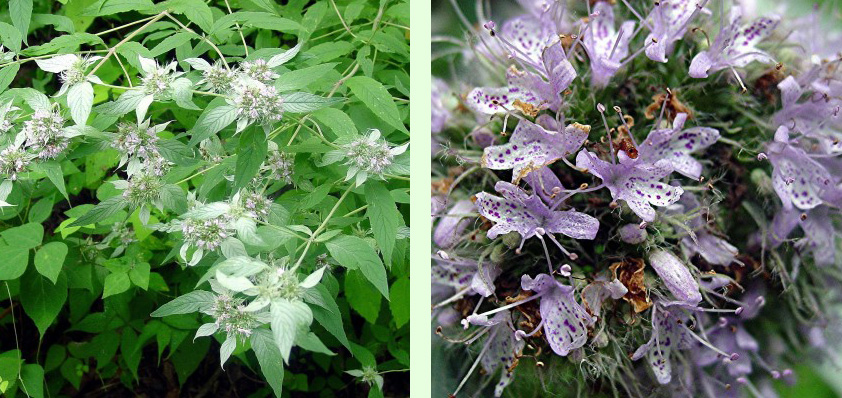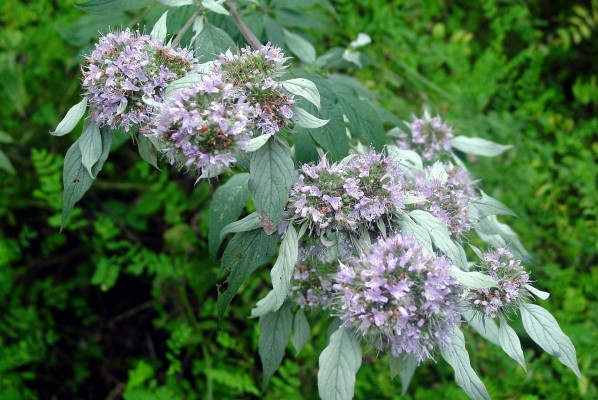By Pat Holder
Mountain-mints are a nearly unmatched food source for a wide array of insects. Bees, butterflies, and other pollinators are drawn to them to sip the minty nectar from summer to fall. All mountain-mints are in the Lamiaceae family and they all have square stems. But each species of mountain-mint has special, specific qualities that capture the hearts of gardeners who love that particular one just a little bit more than the others.
My personal favorite, which is also my very favorite perennial – and this is hard for me to say because I do whisper words of praise and adoration to a great number of native plants – is Pycnanthemum incanum (Hoary Mountain-mint). One note of caution: Mountain-mint is attractive to wasps that will eat and parasitize caterpillars, so plant mountain-mint and milkweed at a good distance apart, preferably not in the same garden!

This erect, many-branched perennial grows to around three feet high or a bit more in rich soil. The leaves are opposite with a toothed margin. Its upper leaves and bracts take on a frosted, whitish appearance, hence the name Hoary Mountain-mint. Pycnanthem incanum’s foliage has a distinct and intoxicating fragrance, delighting pollinators and humans alike. It also makes a delicious tea. This mountain-mint, like some others, also supports conservation biological control. It is able to do this helpful task because it attracts predatory or parasitoid insects that prey on pest insects.
Seed heads are food for birds
Tiny clustered blooms are white, varying to lavender, with purple spots. They appear in multi-layered tiers from summer to early fall. If seed heads are left intact, they create a delightful appearance in the winter landscape, contrasting nicely with the plant’s rigid bare stems. They also provide a valuable source of food for birds at a time when insects are less available. This is one natural way to control pests without chemicals.
But what are the really wonderful qualities of this plant that make me choose it as my favorite? First, it is a very low-maintenance plant. It is easily grown in a wide range of growing conditions, from sun to part-shade and dry to moist soil. Admittedly, this mint’s showy, fragrant flowers are happiest in sun, but they really handle some shade well.
It does well in clay and is deer resistant
In our garden, we have found that Hoary Mountain-mint seems very much at home in our fairly heavy Randolph County clay soil. This is a huge plus! It is also drought tolerant and grows very well, even in dry soil. With its strong roots and tolerance for varying soil conditions, it can help to stop erosion. It is truly wonderful that Hoary Mountain-mint doesn’t seem to mind our summers, which seem to be extremely hot and dry during some years, this past one included.
Hoary Mountain-mint is beautiful, fragrant, low maintenance, and beneficial to many pollinators. There is one more trait that has landed it such a special place in this gardener’s heart: Hoary Mountain-mint is highly deer resistant. In our area, as in many places, there is an overabundance of deer. This is the result of habitat loss, absence of natural predators, and other factors. This mountain-mint provides a beautiful bounty of nectar and pollen despite less than ideal conditions that plague less hardy plants.
This plant should do well in most Piedmont gardens as a mid-border flower or in a meadow garden. Because it is such a strong plant, it can be a bit aggressive. If it starts to expand too much, it is easy to pull it out. You can then share this fantastic perennial with a friend.
By Pat Holder
Native Plant News – Spring 2023

Pat Holder is the coordinator of the North Carolina Native Plant Society’s Native Plant Habitat Certification Program. She is passionate about native plants and their critical connection to the animal life in their surrounding ecosystem. Pat loves working with applicants for certification. She is inspired by their hard work and compelling stories.

